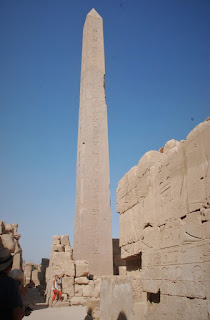It has become prohibited to take photos in the Valley as over the years the ancient colours in the tombs have shown signs of fading because of it. They take a hard line on this, so our memory photos were purchased on site.
There has been a lot written about this site and its significant tombs, so we have kept it rather short. Needless to say, the endeavours of the ancients to prepare for the afterlife were amazing. To what extent you want to find more on this period, or the specific sites, it's all available by internet searching now.
King Ramses IV: The tomb of King Ramses IV has maintained to date a lot of colour on the wall paintings. He came to power late in life and ruled for no more than 6 years.
King Ramses IX: One piece of artwork on the walls on his tomb included a scarab. A scarab is a bug (actually just a dung beetle!) that was a symbol of eternal life and good luck.
King Merneptah: This is the sarcophagus (a coffin usually made from stone) of the King.
Tutankhamun (King Tut): Came to power at the young age of 9 and died approximately 10 years later from unknown causes. Over 5,000 items were found in this tomb including his golden sarcophagus and death mask.
When we visited King Tut's tomb, his mummified body was present for viewing. Eww! What we saw was his visible head and feet with the rest of this body wrapped in white linen and placed in a climate-controlled glass box for preservation and observation.
After the Valley of the Kings, it was over to Hatshepsut Temple where photos were now allowed. Hatshepsut married at the young age of 12, common in those days. The Queen's temple consists of 3 levels and took 15 years to complete; it is considered one of the greatest Egyptian architectural achievements.
Hatshepsut Temple
It's interesting to note that in those days, the people only recognized men as rulers, so Queen Hatshepsut was made up to look like a man. That was enough for the people to accept her as such and permitted a royal afterlife preparation.
To top off our tours, we went to the east side of the Nile to see the Karnak Temple. After Angkor Wat of Cambodia, this is the second largest religious ancient site in the world, and after the Giza Pyramids of Cairo, the second most visited historical site of Egypt.
It consists of 134 massive pillars arranged in towering columns, several colossal statues, and an obelisk carved of solid granite 29.5 m (97 ft) tall and weighing over 320 tons.
Jordan and Judy by pillars
Judy beside a tall obelisk
How did the ancient Egyptians ever manage to construct such diametrically large and weighty projects! What makes Karnak different from other temples is the amount of time over which it was built - more than 2,100 years under several ruling pharaohs!
During our tours, our guide explained that a cartouche is a name spelled with Egyptian hieroglyphs enclosed in an oval with a horizontal line at one end which indicates the name is royal.
Cartouche in tomb at Karnak Temple)
If we wished, he said he could arrange for our names to be done in this way as jewellery. Here is my royal name (silver with gold hieroglyphics), complete with a raised scarab on the back!
Feeling all templed out, it was good to hit the road home to the comfort of Sea Turtle and to see how Chanty, our boat cat, made out without us for 2 days.












No comments:
Post a Comment